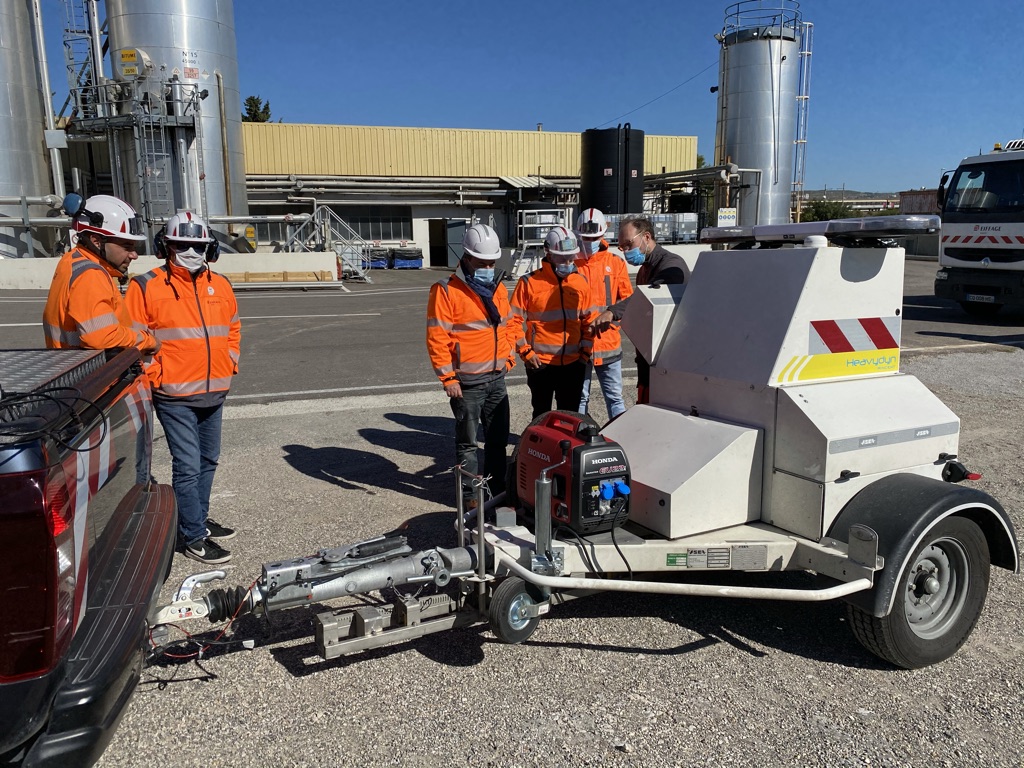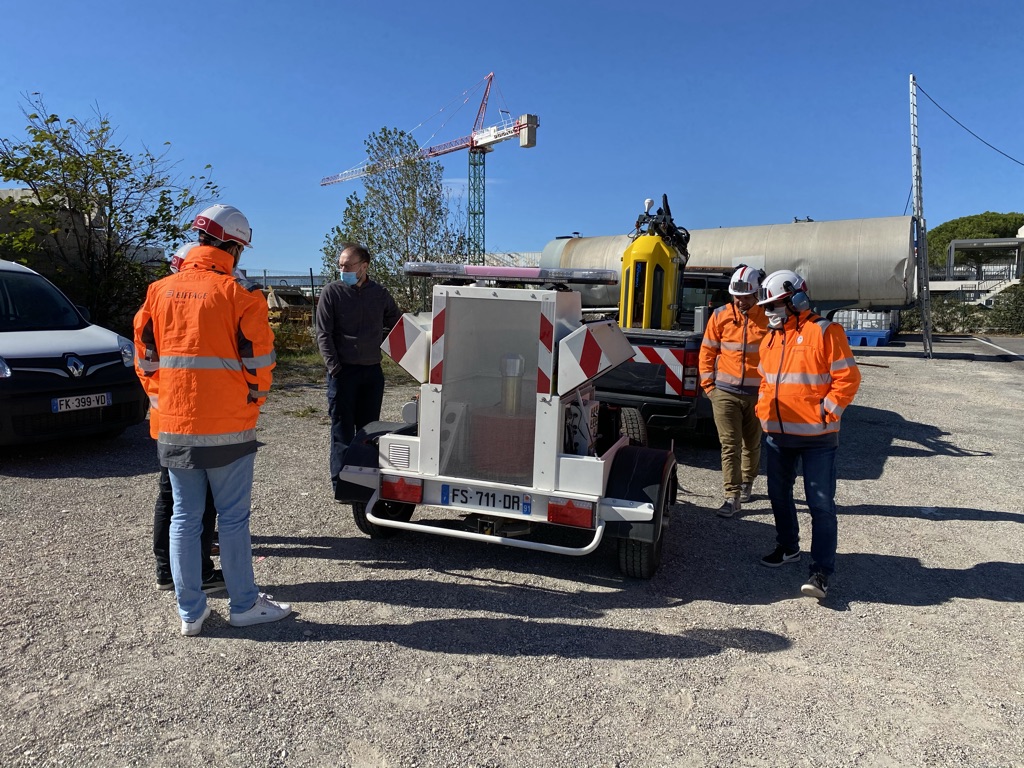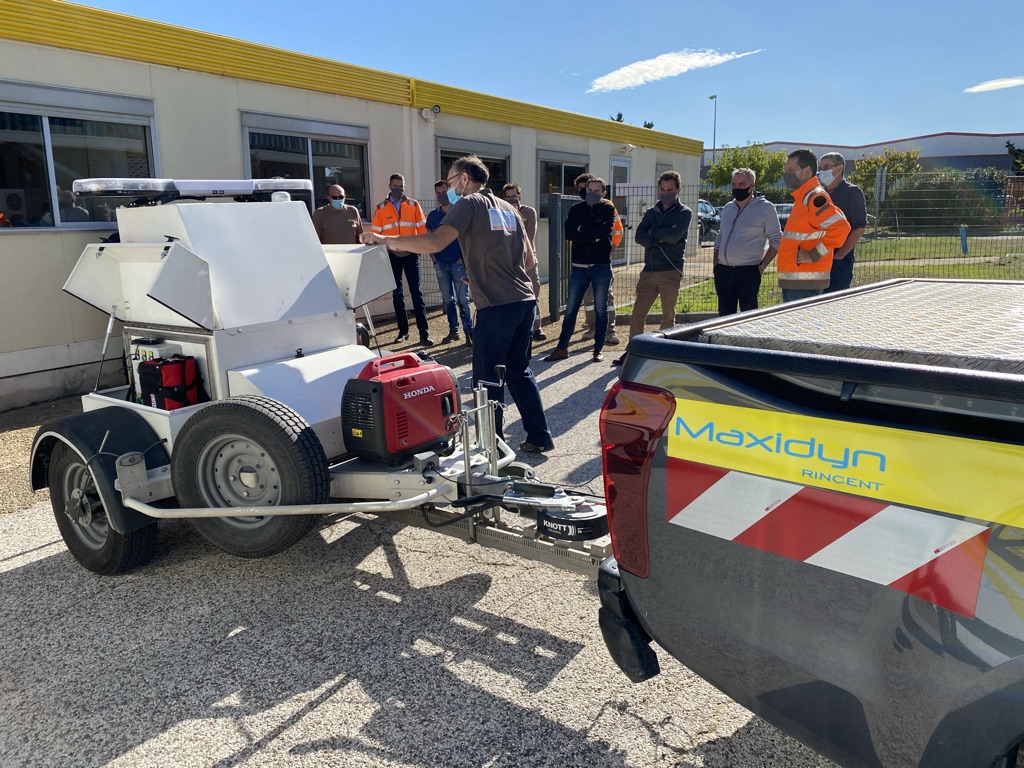Falling Weight Deflectometer test
FWD - HWD

Falling Weight Deflectometer test
The FWD allows for more precise and safe pavement diagnostics.
Evaluation of treated platforms through deflections.
The Falling Weight Deflectometer (FWD) is used in pavement assessment to determine the surface and structural characteristics of road pavements. It employs various non-destructive testing (NDT) methods for measurement.
Its objective is to characterize the level of pavement deterioration and provide essential information for making maintenance decisions.
Measurement of moduli ranging from 20 to 250 MPa, corresponding to platform classes PF1 to PF4.
Testing rate: up to 120 tests per hour.
Testing depth: between 2 and 3 meters, depending on the support.
Measurement of deflection caused by an automated dynamic load and calculation of the radius of curvature.
Retro-calculation: calculation of the modulus for each layer directly within the retro-calculation module of Alize.
Although the FWD has been widely used worldwide since 1980, there is no standard as such, but correlation tests between FWDs have become the mandatory reference: the TRL in the UK has become the standard. international benchmark, and the CROW in the Netherlands is more used for European countries.
In the United Kingdom, the Transport Research Laboratory (TRL) has become the international reference, while in the Netherlands, the Dutch National Road and Transport Research Institute (CROW) is more commonly used for European countries.
Learn everything you need to know about the falling weight deflectometer, how it works, its use in construction and more.
Selecting the right FWD for your project
If you’re looking for a robust, reliable and accurate tool to assess the quality of your pavement projects through deflection and layer moduli, then the Falling Weight Deflectometer (FWD) is the right investment for you.
The trailer is delivered in accordance with the requirements of the French highway code, complete with registration.
Choosing an FWD means choosing precision. Every measurement is taken with unrivalled accuracy, ensuring reliable results on which to base your road maintenance decisions. Whether you need fine detail for a large-scale infrastructure project, or simplicity for a smaller project, the FWD is configurable to meet your specific requirements.
Imagine having the ability to accurately determine the deflections of your pavement, allowing you to predict with certainty its lifespan and maintenance needs. That’s what FWD can offer you.
The FWD is not just a tool, it’s also a quality long-term investment. Every purchase or rental includes full training and ongoing technical support, ensuring you maximise the value of your investment. Its ease of use and maintenance make it a stress-free, hassle-free choice.
Methodology for using the falling weight deflectometer
The first step in using a falling weight deflectometer is to prepare the site by clearing the area of debris and taking accurate measurements of the area to be tested. Once the site has been prepared, the equipment is configured according to the manufacturer’s specifications, which includes calibrating the equipment and entering the necessary data into the associated software.
After configuration, the deflectometer is positioned over the area to be tested with extreme accuracy to ensure the reliability of the data. The test begins by releasing the weight on the surface, which causes a deflection. The sensors record the reactions of the surface, including the magnitude and speed of the deflection.
The data collected by the sensors is then analysed by the associated software, which provides valuable information about the properties of the material under test, such as its strength and elasticity. Finally, the results are analysed and interpreted by qualified engineers or technicians to inform decisions about the construction or repair of the road or airport runway.
Interpretation of results obtained with a falling weight deflectometer
Interpreting the results of a falling weight deflectometer requires technical expertise.
The deflection profile provides information about the strength of materials. This data is used to calculate the back-calculation modulus, indicating the stiffness of the materials.
Variations in deflection can also reveal information about material layers at different depths. A qualified professional is required to interpret these results accurately.
Falling weight deflectometer: history and development
The falling weight deflectometer (FWD), which originated in Scandinavia, was developed in the 1970s as a more practical means of testing pavement strength. Initially used for aeronautical pavements, its use was extended to other types of pavement.
Since the 1980s and 1990s, it has become a common pavement management tool in the United States and other countries. Modern FWD equipment is equipped with advanced computer systems for rapid and accurate data analysis. Today, they remain an essential tool for public works engineers.
Scientific principles behind the falling weight deflectometer
The falling weight deflectometer (FWD) works using the principles of elasticity and fluid dynamics. When a weight is released onto an elastic material such as soil or bitumen, the material deforms and then returns to its original shape.
The FWD measures this deformation. By using a hydraulic system to control the applied force, the FWD can calculate the stiffness of the material, often expressed as Young’s modulus. Interpreting the data requires expertise in soil and pavement mechanics.
Maintenance et entretien d'un falling weight deflectometer

To ensure the durability and accuracy of your falling weight deflectometer (FWD), it is important to clean it after each use. Regular visual inspection will detect any signs of wear or damage. Periodic calibration of the FWD maintains measurement accuracy and software updates ensure that you have access to the latest improvements.
If you have any problems, don’t hesitate to come back to us, and we’ll put you in touch with the appropriate after-sales service. Regular attention to these aspects ensures accurate and reliable service from your FWD over the long term.
Differences between the falling weight deflectometer and other soil testing equipment
The falling weight deflectometer (FWD) stands out from other soil testing equipment because of its non-destructive method, speed and efficiency. It provides detailed information on the surface and underlying layers of the soil.
Thanks to its integrated software, data analysis is fast and accurate, facilitating your project decisions.
Materials used in the manufacture of a falling weight deflectometer
A falling weight deflectometer is made from a variety of materials to ensure robustness and accuracy. The main structure, comprising the frame, weight and load plate, is generally made of steel for strength and durability.
The FWD’s sensors, which measure surface deflection, are made up of various electronic components such as semiconductors, resistors and capacitors.
The weight-release system includes hydraulic components that are resistant to pressure and wear, while non-essential parts, such as the electronics housing, are often made of plastic for their lightness.
Specific safety rules for using the falling weight deflectometer in wet conditions
When using a falling weight deflectometer in wet conditions, it is essential to take extra precautions to ensure safety and accuracy. Protect all electronic components of the FWD from moisture to prevent damage to the equipment. Ensure that the FWD is stable on the wet surface to prevent slipping. The operator must wear non-slip shoes and appropriate protective equipment.
Ensure that the work area is well lit and clearly signposted, and take all necessary precautions to avoid the risk of electric shock.
Importance of pressure sensors in a falling weight deflectometer
The pressure sensors in a falling weight deflectometer (FWD) are essential for measuring the deformation of the surface under the impact of falling weight. These precise measurements provide essential information about the structure and stiffness of the pavement or ground. This data is then analysed to assess the structural condition of the pavement, making pressure sensors crucial to the effective operation of the FWD.

Preparing the site for FWD use
Preparing the site for use of the Falling Weight Deflectometer (FWD) is an important step in ensuring accurate measurements. This starts with a thorough inspection of the site to identify the areas to be tested and any obstacles. The surface to be tested must be clean, free of debris that could affect the accuracy of the measurements. The equipment must also be checked to ensure that it is working properly and calibrated if necessary. The test points must be carefully selected to ensure an accurate representation of the entire road surface.
Finally, it is important to take weather conditions into account, with tests preferably carried out in dry weather to avoid interference from rain or frost.
Training required to use the FWD
Effective use of the FWD requires specific training. Operators must understand the basic principles of FWD operation and deflection measurement. They must also be trained in the correct use of the equipment, including its configuration, calibration and maintenance.
An important part of the training is the interpretation of the data collected, to understand the implications of the different deflection measurements. Finally, safety is paramount when using heavy equipment such as the FWD, which also requires appropriate training. In short, proper site preparation and thorough training are essential to ensure accurate and reliable measurements with FWD.
Frequently asked questions
The software incorporates measurements of deflection (via geophones), drop height, impact force, weight of the falling mass, test date, pavement surface temperature, air temperature, location (GPS), and distance between measurement locations (odometer).
The Falling Weight Deflectometer (FWD) or Fallingweight Deflectometer is derived from a device studied in France by the Central Laboratory of Bridges and Roads (LCPC) in 1963, called the boulet deflectometer. The principle of this device was adopted by the Technical High School of Denmark and the Danish company Phoenix.
In 1976, the FWD gained official recognition from the Danish authorities as a means of pavement assessment. The Danish equipment was tested by the Swedes in 1974, and the Swedish company Kuab constructed its own equipment in 1976.
The Danish group Dynatest exported the FWD to the United States in the late 1970s. Today, the FWD is a recognized method of pavement assessment, especially in Anglo-Saxon countries.
“The Falling Weight Deflectometer (FWD) is considered to be a precise and reliable deflectometer in terms of accuracy and repeatability.
The reproducibility of this equipment depends on compliance with very stringent calibration procedures.
However, these procedures do not guarantee reproducibility between devices using different technologies. Given its metrological performance and measurement rate, the FWD is well suited to research trials or to the very precise monitoring of control sections.
This is how it is used in France. It is also conceivable to use it as part of maintenance studies on relatively short sections of flexible pavements, especially if you want to use the information to design a structural maintenance operation. Some European countries use this device quite frequently in this context.
The European guide to the use of the FWD for maintenance studies on flexible pavements, currently being published under the aegis of the FLERR, sets out the conditions for this type of study”.

